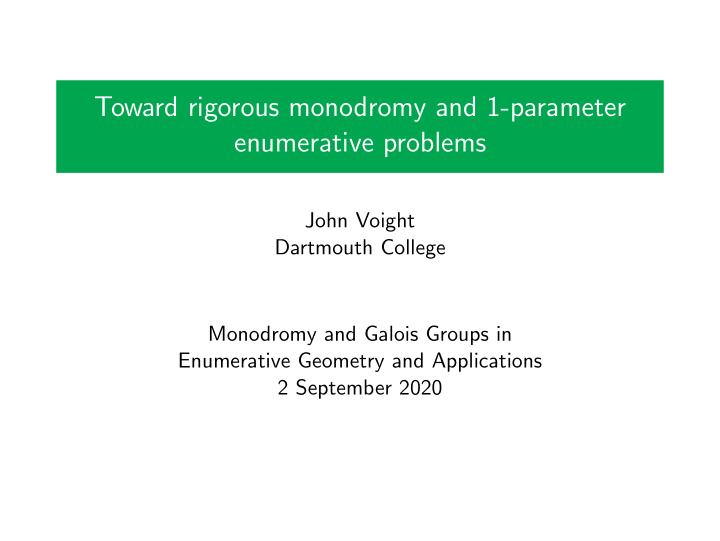



Toward rigorous monodromy and 1-parameter enumerative problems John Voight Dartmouth College Monodromy and Galois Groups in Enumerative Geometry and Applications 2 September 2020
Overview The talk is in two parts and will focus on questions and problems. 1. Algorithmic and computational questions concerning Belyi maps and Hurwitz spaces, especially rigorous monodromy. 2. Understanding some curves of enumerative problems
Hurwitz schemes A Hurwitz space is a moduli space of branched covers of the projective line P 1 with a fixed, finite monodromy group. A Hurwitz space is specified by its monodromy and branching data, which we call its (refined) passport : ◮ The monodromy group G ≤ S d ; ◮ The branching data, as r conjugacy classes in either S d or in G ( refined ).
Belyi maps: monodromy of the base A Hurwitz space with r = 3 is zero-dimensional; a branched cover φ : X → P 1 with ramification in { 0 , 1 , ∞} is called a Belyi map . A passport is specified by G ≤ S d and three permutations σ 0 , σ 1 , σ ∞ ∈ S d such that σ ∞ σ 1 σ 0 = 1 ( permutation triple ) up to simultaneous conjugation . Given a (refined) passport, the base (Hurwitz space) is a finite algebraic set. What is its Galois group? The absolute Galois group Gal Q := Gal( Q al | Q ) acts faithfully on the set of isomorphism classes of Belyi maps. Question (1) Are there heuristics that predict the decomposition of a passport? What is the probability that a (refined) passport is irreducible?
Belyi maps: LMFDB We made a database! http://beta.lmfdb.org/Belyi
Belyi maps: algorithmic questions Question (2) Is there an algorithm that takes as input a permutation triple in S d and produces as output a model for the associated Belyi map φ : X → P 1 over Q al that runs in time doubly exponential in d? In genus zero, one can write down equations. (Is there a cubic polynomial φ ( x ) ∈ C [ x ] such that both φ ( x ) and φ ( x ) − 1 have a double root?) Question (3) Does question (2) have a positive answer, in theory or in practice, in genus zero? (Do numerical homotopy methods work?) Question (4) Is there an algorithm that computes a model for M g , n ? Klug–Musty–Schiavone–V exhibited a general purpose, numerical method for (2) that works in practice, but requires verification.
Rigorous monodromy Joint work with Joshua Perlmutter ’20: we have certified the monodromy groups of all but a handful of the maps in the LMFDB. We used the SageMath implementation due to Bruin–Sijsling–Zotine and implemented the work of Beltran–Leykin into Python. Question (5) Did we legit prove a theorem, or do we we have to worry about round off error and need to use ball arithmetic? Question (6) What other implementations exist for certifying monodromy of branched covers defined over number fields (ensuring no path jumping or round off error)?
Rigorous monodromy, but large height The input often has large height and the methods seem to be sensitive to the model entered. The model 7T3-3.3.1-3.3.1-3.3.1-a takes hours or days; after a linear-fractional change of variable, we instead can work with ( ν 2 − ν + 1 = 0) ( x + (4 ν − 2))(2(6 ν − 3) x 2 + 6 x + 4(3 ν − 5)) 3 φ ( x ) = ( x + ( ν − 1))((6 ν − 3) x 2 − 6( ν + 1) x + 4( ν + 5)) 3 which completes in seconds. Question (7) What (numerical?) preprocessing should be used to reduce the running time?
If time, short dance break
Relaxing enumerative problems: setup Recall that for d ≥ 2, given 3 d − 1 points in general position in P 2 , there are finitely many degree d rational curves through them. For example, there are 12 rational plane cubic curves through 8 points. An amazing recursive formula for these numbers is due to Kontsevich. Question (8) Did someone already prove that the monodromy group of this enumerative problem is the full symmetric group? Take one fewer!
Relaxing enumerative problems Take one fewer: consider the curve’s worth of rational curves through 3 d − 2 points in the plane. For d = 1, we get lines through the origin: that’s P 1 . For d = 2, by linear algebra we again P 1 for the conics through four general points. For d = 3, the space of cubics through 7 general points in the plane is three-dimensional; the loci of rational curves (insisting that the cubic has a node) describes a plane curve of degree 12. The arithmetic genus is 55 and the geometric genus is 3. Question (9) What is the (geometric and arithmetic) genus of the curve parametrizing 3 d − 2 general points in the plane? It is connected? What is its automorphism group? Concerns the codimension 1 geometry of a Severi variety.
Graphic Go to SageMath.
Conclusion We presented ◮ some algorithmic problems concerning Belyi maps as Hurwitz spaces, and ◮ a question on relaxing enumerative problems to 1-dimension. Please share your thoughts and comments, and thank you for your attention!
Recommend
More recommend